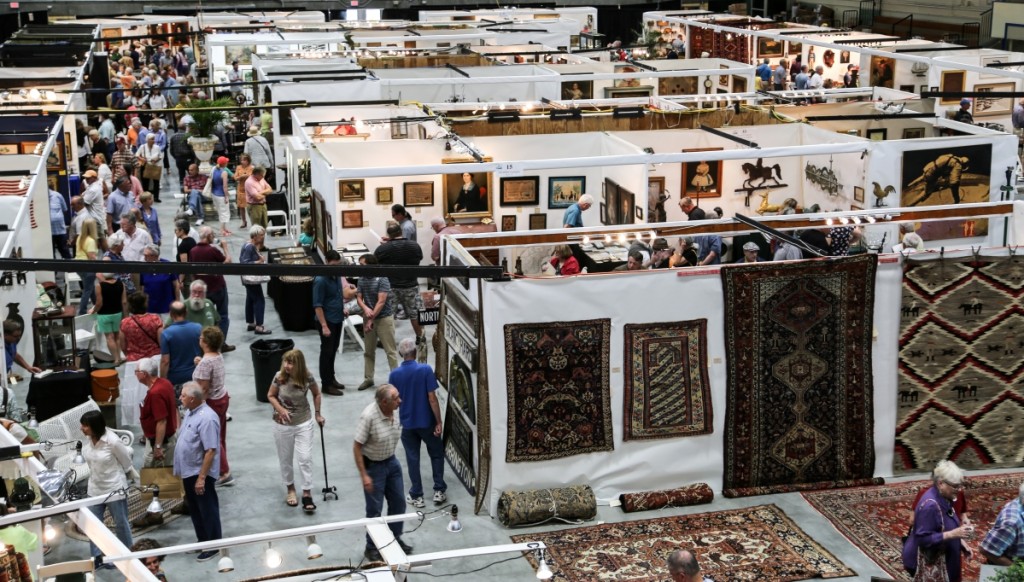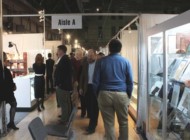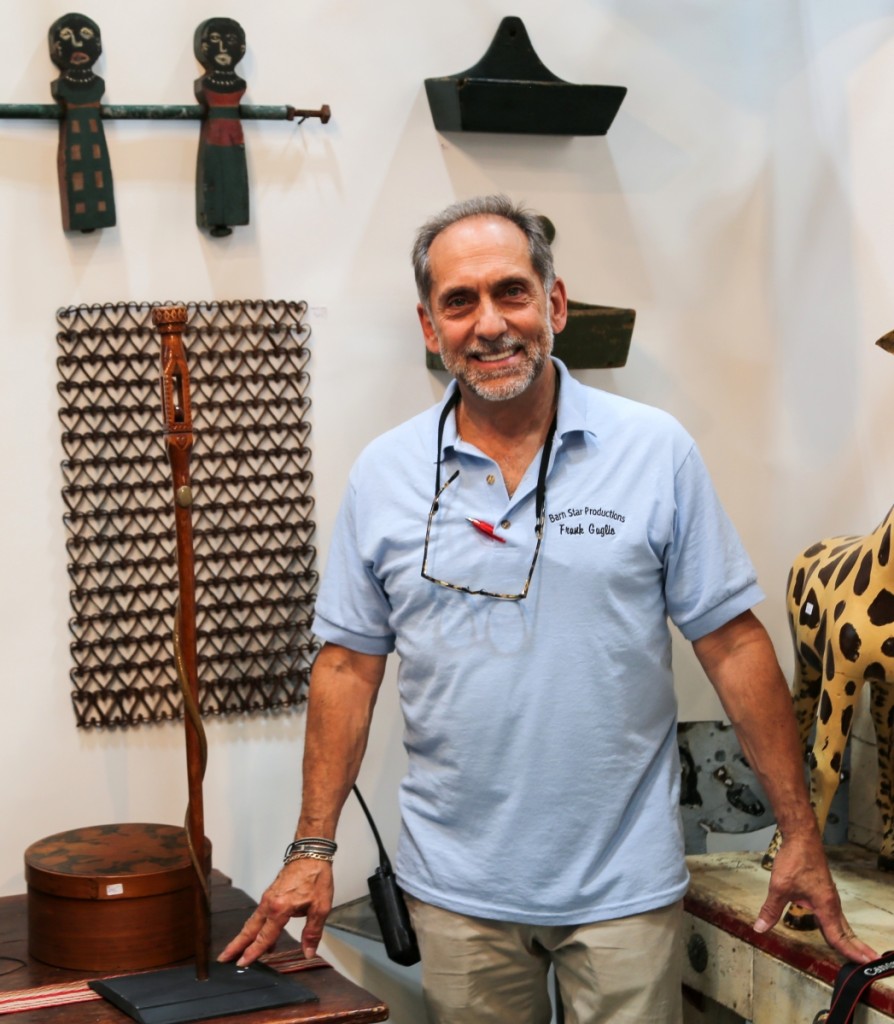
Frank Gaglio started the MidWeek show, and consequently Antiques Week in New Hampshire, in 1994, and he stands here 25 years later celebrating the show’s longevity.
Review and Onsite Photos by Greg Smith
MANCHESTER, N.H. – Twenty-five years have passed since show manager Frank Gaglio jumped into the lion’s den and laid the foundation for Antiques Week in New Hampshire. At the time, the only girl in town was the New Hampshire Antiques Show, then as it is now comprising 60-some dealers with a long waiting list behind it, and Gaglio saw an opportunity to expand – even if that show and its dealers preferred it not.
“When I announced the show, many dealers thought the sky was falling,” Gaglio told Antiques and The Arts Weekly. “They didn’t understand that I had a vision. I was modeling New Hampshire after the Nashville Show, how Heart of Country started and then Jenkins came around and expanded.”
Forget about the venue, the state and even the region, the New Hampshire Antiques Show was the only notable show in August at the time, and that strict number of exhibitors, plus the waiting list, meant that business was slow for the rest of the trade. Others wanted in and MidWeek was born.
Gaglio started the show in 1994 at the Wayfarer Inn, where it remained for 16 years until the building was demolished. The inn had a convention center where 25 dealers set up, ten additional dealers in the hallways and the bulk, about 75 more, in a large tent.
As we sat together in the show’s current venue, the JFK Memorial Coliseum in downtown Manchester, MidWeek’s home for the past three years, Gaglio looks back and describes the show’s chilly reception with a smile. “It took a bold little Italian from Brooklyn,” he joked. “Dealers were fearful of retaliation, worried some other dealers wouldn’t buy from them anymore. But I believed I was changing the show in a positive way…and changing how people bought. Once I announced it, dealers started calling.”
Over the years, a great number of dealers have exhibited at Gaglio’s show. Some have moved on to one of the other five shows that now make up Antiques Week in New Hampshire, and others still come to buy. “People came from all over,” Gaglio said, “It became a social event as well as a commercial event. More than anything, it was so great to pull people together and see them happy and having fun with antiques.
“So we had the dealers. And the New Hampshire Antiques Show was and is just as strong…and then eventually more shows started to open around us.
“And we always endeavored to be respectful of the NHADA’s New Hampshire Antiques Show,” Gaglio continued. “It’s a great show. Without them being at the head of the list, I may not have started MidWeek. So I have very warm feelings for every one of them and I thank them.”
After the inn was demolished, the show moved to a spacious building where a Furniture World once was, some of the vignettes still waiting to be filled. Gaglio transformed it, creating booths around the entire building. It lasted there for about five years.
The latest edition of MidWeek brought 42 dealers together on August 7 for another first: instead of opening for its usual two days, the show would open the doors for six hours only on Wednesday.
“The one-day concept is something that I’ve been exploring for a while, but as the business matures, I think a one-day format is going to have an appeal to all parties involved.” Gaglio mentioned the cost savings to exhibitors while still opening up for the hungry crowds of antiques buyers that swarm the city.
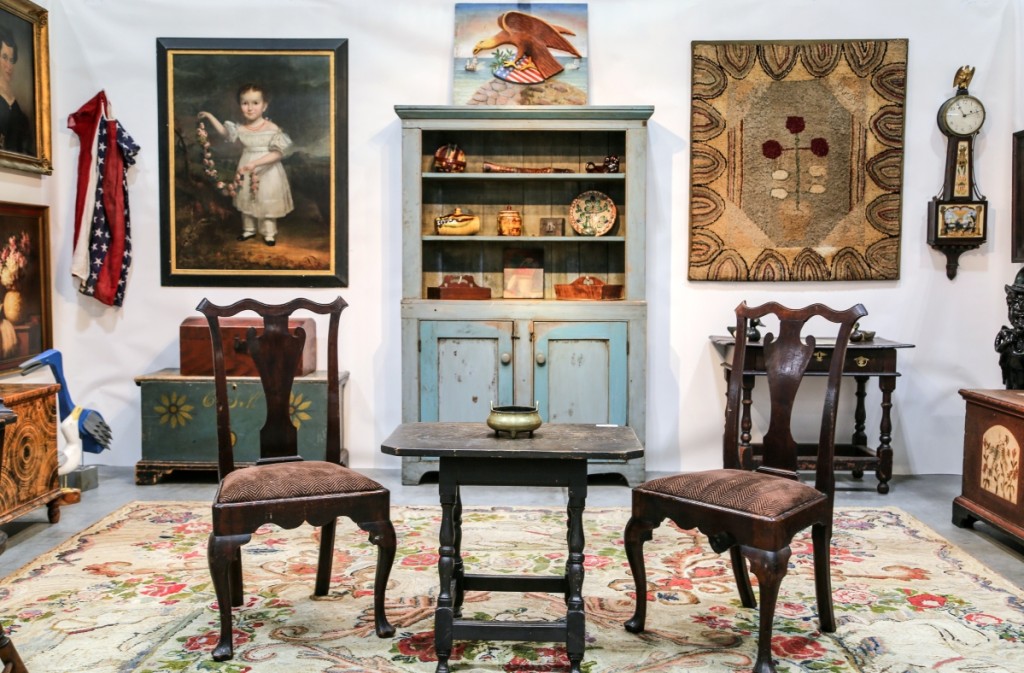
Allentown, Penn., dealer Thurston Nichols American Antiques featured a William and Mary New England turned tea table, circa 1750, at the center of the booth. The dealer also had an exceptional Pennsylvania paint-decorated chest by fraktur artist Heinriech Otto, circa 1790, in its original paint.
The 25th anniversary of MidWeek was dedicated to dealer Robert Perry, who passed away in December, 2018. He was a staple at the show in years past, exhibiting Americana, folk art, paintings and painted furniture. Gaglio called him “an enthusiastic dealer, a great friend, full of smiles, dedicated to his craft.”
Lee Hanes from Hanes & Ruskin, Old Lyme, Conn., related that he had a terrific show. “Fantastic is the word – really fantastic,” he said. Hanes said that he sold furniture, ceramics, brassware and paintings, including an American portrait dated 1841 featuring a 5-year-old Henry Hill sitting with his dog. Hanes also sold a Prior painting featured on the outside of his booth to a new client. “For the first three hours, it was just jumping,” he said, “and I was busy for all six hours.” He said that he’ll be at the show again next year.
Auctioneer of yore Jim Julia has moved into private dealing under the name FFO Antiques, still based in Fairfield, Maine, and the dealer set up for the first time at MidWeek this year. FFO stands for Fly Fishing Only, one of Julia’s favorite pastimes. FFO Antiques does not have an open gallery but maintains an online catalog and has a few booths in antiques malls. In the booth at MidWeek was a Civil War 35-star Guidon flag for the 2nd Mass Cavalry, Company K, made by A.W. Pollard in Boston. It was joined by two Antonio Jacobsen paintings, one showing the single stack two-masted San Jacinto and the other the four-masted schooner Adelaide Barbour. FFO also featured a number of decoys, including a carved tern by Elmer Crowell, a rigmate pair of mallards by Charles Perdew and a scoter by Wendell Gilley.
Dennis and Valerie Bakoledis, Rhinebeck, N.Y., also had a fine show, saying that sales were brisk. “I did a dozen sales right off the bat,” Dennis said, including a Nineteenth Century copper American banner weathervane, samplers, theorems and early lighting. “It continued for quite a while, folks stuck around. It was the best looking show Frank has had in the past couple years. I saw a lot of good sales out there.”
New to the show this year were Jan and John Maggs, Conway, Mass., specialists in early English oak furniture, jewelry, accessories and paintings. Reached after the show, John Maggs related that they had a strong show and sold a James II oak coffer, mid to late 1600s in near pristine condition. The center panel carved with three acorns sprouting from a stylized oak tree. “It was the best coffer we’ve ever owned,” Maggs said, and it sold to a longtime client of theirs. The dealer also said they sold plenty of Georgian jewelry from their cases, many pieces to new clients.
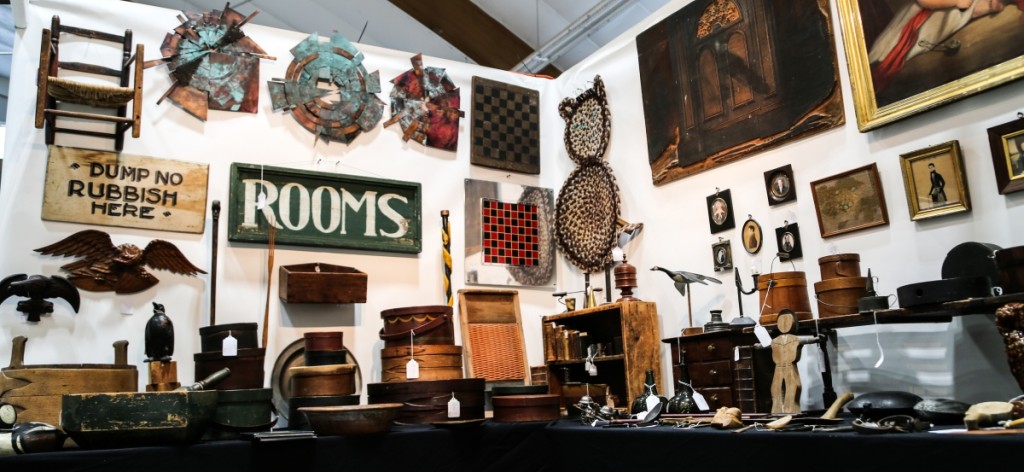
Salem, N.H., dealer Brett Cabral came with a nice mix of country accessories, trade signs, firkins, figures and more. He pointed out a set of brutalist copper wall sculptures at the top of his booth that were done by Sergei Gritsay, an artist who immigrated to the United States from Ukraine.
Also new to the show was Steve Smoot Antiques & Navajo Textiles, Lancaster, Penn. Some of the textiles offered included a fine Navajo Germantown weaving, circa 1900; a Navajo handspun wool child’s Serapi, circa 1875-85; and a circa 1910 Navajo Germantown Masonic rug. The opening to the dealer’s booth featured an impressive display of Northwest totems, ranging in size up to 14 inches. A wood inlaid marquetry table featured a red sold dot early on in the dealer’s booth.
At the center of Blue Line Antiques’ booth, Port Leyden, N.Y., was a glowing red painted three-panel oil on canvas screen depicting the Stadt Huys in New York City. The building is described as New York City’s first municipal building in the Seventeenth Century. The dealers also featured fraternal axes, trade signs and an elaborately carved gourd canteen dating to the Civil War.
Bill and Joyce Subjack of Neverbird Antiques, Surry Va., featured a nice collection of ephemera in the show, though they said sales were soft in that category. Among the works on offer was a Civil War pardon application that was personally signed and denied by Abraham Lincoln. The pardon had been requested by a Union soldier whose communications had been intercepted as he wrote to his father, a Confederate soldier. Lincoln approved 343 pardons between 1863 and 1865 for Confederate soldiers who agreed to sign an oath of allegiance to the Union, but Subjack said he had never seen a reject. The sales that the Subjacks did report were across categories, including an oil painting, a New York City playbill, a presidential signed document and more.
Pat and Anita Holden of Holden Antiques, Sherman, Conn., reported a successful show, with sales ranging from $20 to $15,000. “I thought the one-day format was really good,” Pat Holden told Antiques and The Arts Weekly. “I’d like to have it start a little earlier, but I thought it was good. We sold a lot of stuff. People were spending money; they made decisions quickly. There was a broad interest level, some people were looking for specific things to add to their collections, while others were casually walking around.”
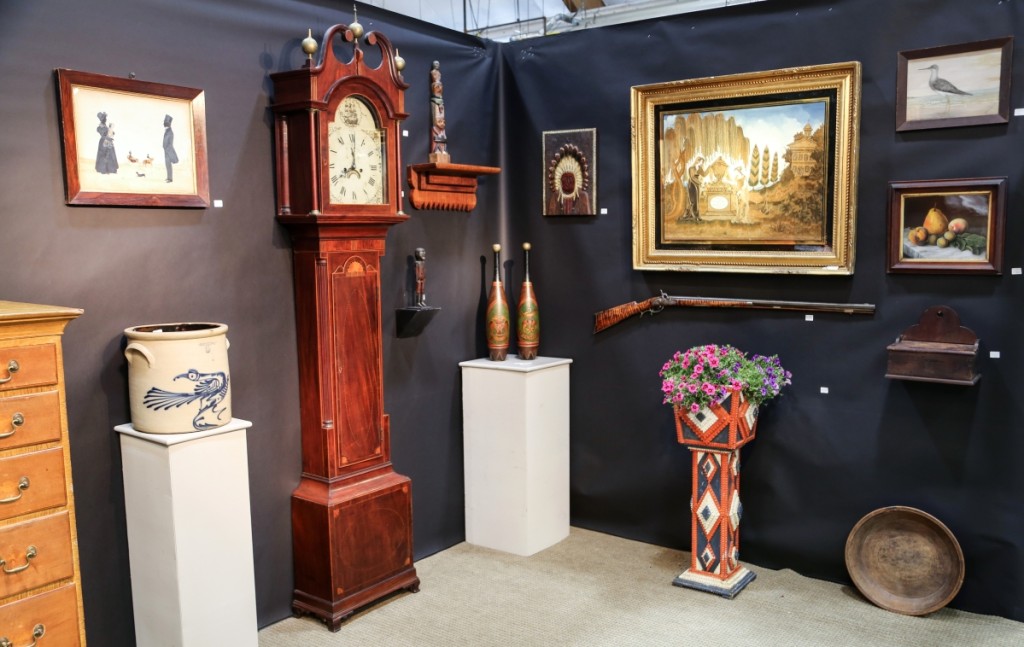
Jim Grievo, Stockton, N.J., said he had a great show. In addition to a number of smalls, he sold the two-handled crock with the bird decoration pictured here to a buyer. Also shown here is a Flemington, N.J., case clock; a pair of Shriners of New York City clubs in original condition; and a Nineteenth Century Fallwell needlework from Philadelphia above a Kentucky tiger maple rifle signed J.M Wood.
Cedar Rapids, Iowa dealer Tom van Deest returned to the show after ten years with his inventory of carvings, primitives, paintings, silhouettes, painted Americana, weathervanes and more. “Business at the opening was very aggressive,” he said, “and I’ve sold seven things more since I’ve returned home.” The dealer exhibited a set of six horse-drawn circus wagons by a Wisconsin man named Connor. The artist carved and painted 36 of these wagons from the 1940s through the 1970s and van Deest owned all but two or three. Connor had a naïve carving style and would exhibit his circus parade at reunions and county fairs. He may have been influenced by the landscapes in Baraboo, Wis., where the circuses were known to winter. Among van Deest’s sales was an exotic fish calligraphy drawing by John J. Stove that was exhibited at the Museum of American Folk Art and had provenance to Peter Tillou. He also sold a long diddley bow instrument from the Blues era of the 1930s, the top carved with the head of W.C. Fields in a top hat. Other red tags included stoneware, walking sticks and folk art figures.
Three hours after the show opened, Gaglio regaled his guests with a 25-year celebration party dinner, free of charge to attendees with admission. A full-blown catered affair – Gaglio said attendees really enjoyed and appreciated the party.
“I hope to do the show for 25 years more,” Gaglio said. “Change is always a challenge, whether it’s a facility or state of the business, but change puts us at our creative best to keep things moving forward.”
For additional information, www.barnstar.com or 845-876-0616.

